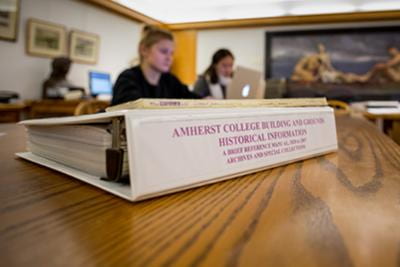Here at the Amherst College Archives, we love sharing with our readers all the fascinating (and sometimes hidden) stories we find in the archives. But we also love sharing with you how we make it possible for researchers to find those stories themselves. It’s important to take our researchers behind the scenes to understand how the archives profession works. The department has been working on a strategic plan to better improve access to our archival material, and we’d like to share a small but crucial section of that plan. In short, our processing team is preparing to take stock of our entire collection and ensure that any hidden collections are made visible to the public.
What’s a hidden collection? Basically, any collection that the researcher does not know of – because there is no online presence to signal that it exists. Because of past professional practices emphasizing highly detailed archival processing, institutions often accumulate extensive backlogs of material to be processed.
Archival practice has moved steadily away from the practice of describing collections in exhaustive detail. Greene and Meissner’s seminal article “More Product, Less Process: Revamping Traditional Archival Processing” appeared in 2005, issuing a challenge to “many of the assumptions archivists make about the importance of preservation activities in processing and the arrangement and description activities necessary to allow researchers to access collections effectively.” Ten years later, Daniel Santamaria published Extensible Processing for Archives and Special Collections: Reducing Processing Backlogs (ALA, 2015), taking the More Product Less Process (MPLP) approach even further: “Extensible processing offers an alternative, allowing collection managers to first establish a baseline level of access to all holdings, then conduct additional processing based on user demand and ongoing assessment. Adhering to archival principles and standards, this flexible approach emphasizes decision-making and prioritization.” What both of these approaches have in common is a focus on users and access, rather than descriptive work by archives staff.
Here at Amherst, we are inspired by these monumental shifts in our profession. And we’re looking to overhaul and systematize our internal practices to better reflect these recent developments in archival theory and practice.
One immediate goal for the department is to conduct a shelf-by-shelf review of our holdings to ensure that a minimal record exists for every collection in our care, in line with the principles of extensible processing mentioned above. A minimal record means that we’ll offer a description of the collection online – it might take the form of a short finding, an abstract on the Archives’ Collections and Holdings page, or a library catalog record. Once we have a handle on this fundamental aspect of collections management, we can determine priorities and establish timelines.
We intend for the survey to accomplish the following goals:
-
- Identify hidden collections. Ensure that a minimal record for every collection exists and is publicly available.
- Assess each unprocessed (or reappraised) collection to determine ideal minimal processing level.
- Assign a high/medium/low processing priority to each collection.
- Look for preservation issues. Identify issues that could be addressed and investigate how to tackle these issues.
- Determine recommendations for digitization priorities.
- All collections that currently have only paper finding aids will be moved into our archival collections database (which is keyword-searchable).
- All accessions will be recorded in the collections database.
In the end, even if we accomplish half of these goals, the result will be a stronger archives program based in consistency and transparency for the researcher.
And what does that mean for this blog? Simply that our posts will mostly focus on highlights of the reappraisal survey – but that certainly means that we’ll be unearthing more stories to share!

One thought on “Big Changes in the Works …”